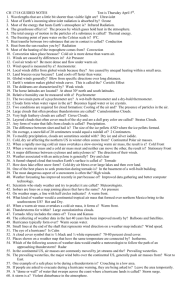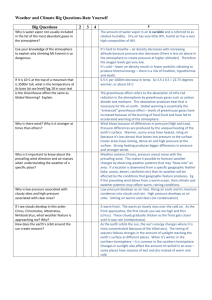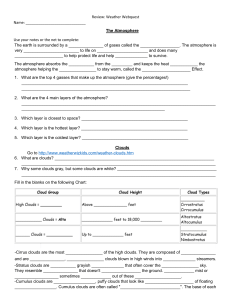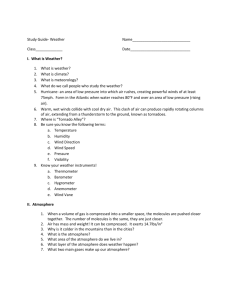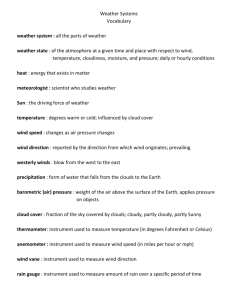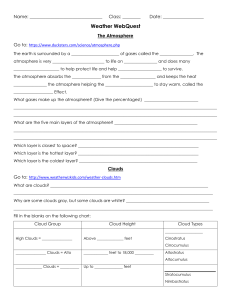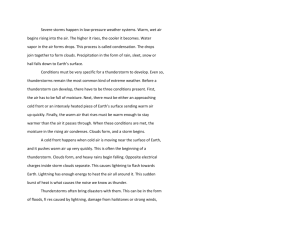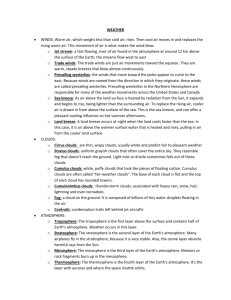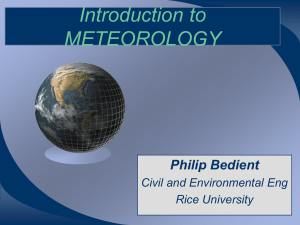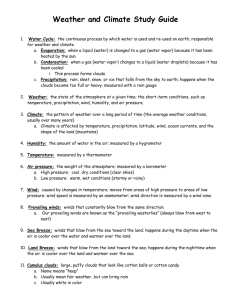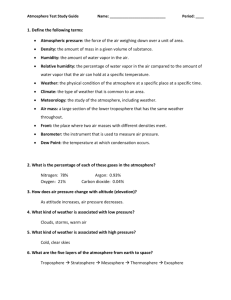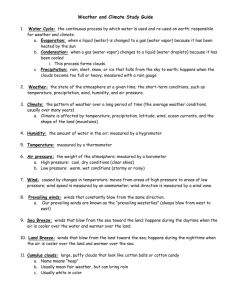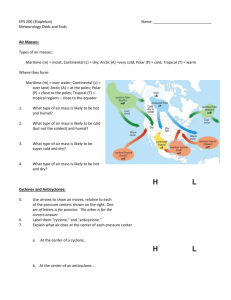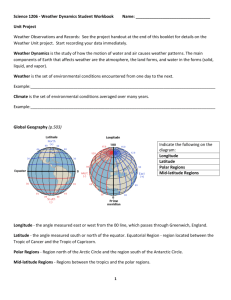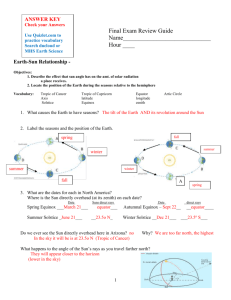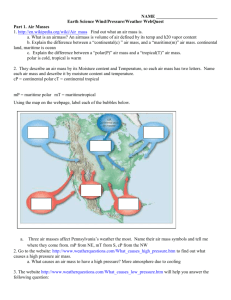6th Grade Science – Objective One STUDY GUIDE 1. The layer of
advertisement
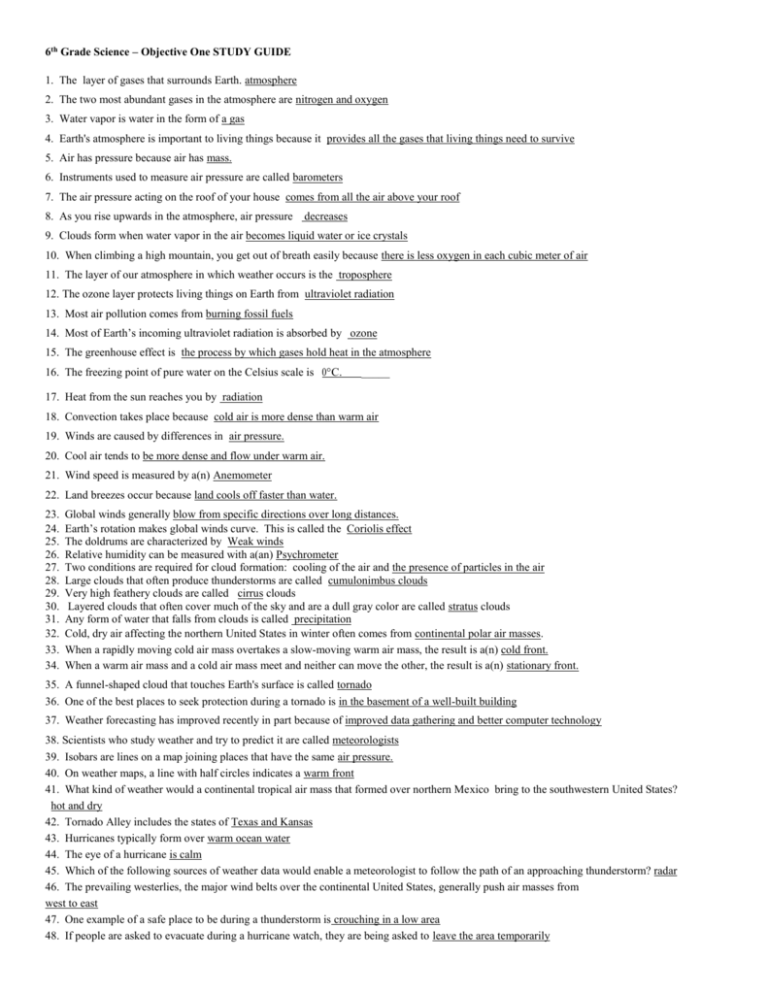
6th Grade Science – Objective One STUDY GUIDE 1. The layer of gases that surrounds Earth. atmosphere 2. The two most abundant gases in the atmosphere are nitrogen and oxygen 3. Water vapor is water in the form of a gas 4. Earth's atmosphere is important to living things because it provides all the gases that living things need to survive 5. Air has pressure because air has mass. 6. Instruments used to measure air pressure are called barometers 7. The air pressure acting on the roof of your house comes from all the air above your roof 8. As you rise upwards in the atmosphere, air pressure decreases 9. Clouds form when water vapor in the air becomes liquid water or ice crystals 10. When climbing a high mountain, you get out of breath easily because there is less oxygen in each cubic meter of air 11. The layer of our atmosphere in which weather occurs is the troposphere 12. The ozone layer protects living things on Earth from ultraviolet radiation 13. Most air pollution comes from burning fossil fuels 14. Most of Earth’s incoming ultraviolet radiation is absorbed by ozone 15. The greenhouse effect is the process by which gases hold heat in the atmosphere 16. The freezing point of pure water on the Celsius scale is 0°C. _____ 17. Heat from the sun reaches you by radiation 18. Convection takes place because cold air is more dense than warm air 19. Winds are caused by differences in air pressure. 20. Cool air tends to be more dense and flow under warm air. 21. Wind speed is measured by a(n) Anemometer 22. Land breezes occur because land cools off faster than water. 23. 24. 25. 26. 27. 28. 29. 30. 31. 32. 33. 34. Global winds generally blow from specific directions over long distances. Earth’s rotation makes global winds curve. This is called the Coriolis effect The doldrums are characterized by Weak winds Relative humidity can be measured with a(an) Psychrometer Two conditions are required for cloud formation: cooling of the air and the presence of particles in the air Large clouds that often produce thunderstorms are called cumulonimbus clouds Very high feathery clouds are called cirrus clouds Layered clouds that often cover much of the sky and are a dull gray color are called stratus clouds Any form of water that falls from clouds is called precipitation Cold, dry air affecting the northern United States in winter often comes from continental polar air masses. When a rapidly moving cold air mass overtakes a slow-moving warm air mass, the result is a(n) cold front. When a warm air mass and a cold air mass meet and neither can move the other, the result is a(n) stationary front. 35. A funnel-shaped cloud that touches Earth's surface is called tornado 36. One of the best places to seek protection during a tornado is in the basement of a well-built building 37. Weather forecasting has improved recently in part because of improved data gathering and better computer technology 38. Scientists who study weather and try to predict it are called meteorologists 39. Isobars are lines on a map joining places that have the same air pressure. 40. On weather maps, a line with half circles indicates a warm front 41. What kind of weather would a continental tropical air mass that formed over northern Mexico bring to the southwestern United States? hot and dry 42. Tornado Alley includes the states of Texas and Kansas 43. Hurricanes typically form over warm ocean water 44. The eye of a hurricane is calm 45. Which of the following sources of weather data would enable a meteorologist to follow the path of an approaching thunderstorm? radar 46. The prevailing westerlies, the major wind belts over the continental United States, generally push air masses from west to east 47. One example of a safe place to be during a thunderstorm is crouching in a low area 48. If people are asked to evacuate during a hurricane watch, they are being asked to leave the area temporarily 49. The cycle of heating, rising, cooling, and sinking is called a convection current 50. What is the most abundant gas in air? nitrogen Use the diagram to answer each question 51. In diagram X, from which way does the wind blow? Land 52. In diagram Y, from which way does the wind blow? Sea 53. Which diagram shows the formation of a sea breeze? diagram Y 54. Which diagram shows the formation of a land breeze? diagram X 55. In diagram X, which cools more quickly, the land or water?. land Use the diagram to answer each question 56. 57. 58. 59. 60. What does A represent? In what direction is it moving? cold front, south What is B called? isotherm What does D represent? In what direction is it moving? warm front, east What does E represent? stationary front What does F connect? points of equal air pressure



